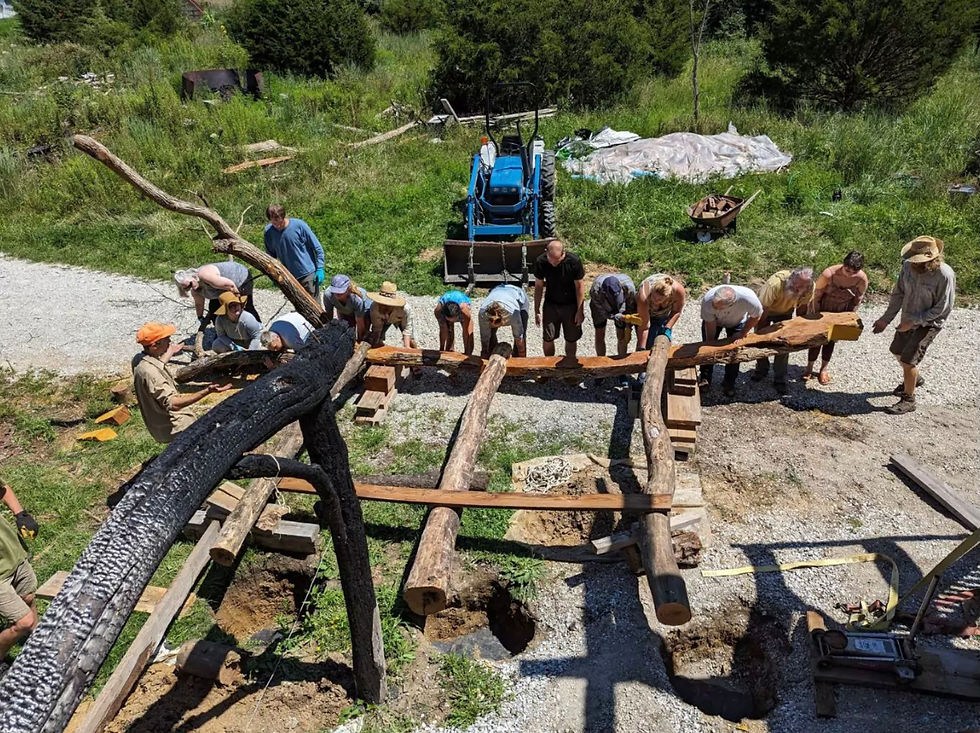Together Resilient: Building Community in the Age of Climate Disruption- Book Review
- achawla0
- Aug 4
- 4 min read
Updated: Aug 23
By Eleanor Wester

Eco-village at Ithaca, Photo courtesy of Jim Bosjolie
When I think of a strong community, a few things come to mind: neighbors willing to watch my cat for the weekend, farmers' markets, bake sales - the list goes on. Being part of a community supports our mental, physical, and emotional well-being. It means having people around you that you can depend on, and who can depend on you in return. The benefits of a strong community are numerous and well understood. But recently, one benefit has been brought to my attention that will only become more paramount - Community for Climate Resilience.
This is the idea that in the face of mounting climate catastrophes, fostering community is imperative. From carbon reduction to disaster preparedness, maintaining a strong, interconnected network is a necessary tool for mitigating and adapting to the effects of climate change. My interest in this topic led me to read and review the book Together Resilient, a comprehensive and well-researched guide for anyone looking to join or learn about the climate communities movement.
This book, written by Ma’ikwe Ludwig, focuses primarily on eco-villages/communities in the United States. In general, these groups are characterized by sharing resources, a heightened value of environmental stewardship, and dramatically lowered carbon and ecological footprints. Eco communities across the country vary in practice. Housing can range from independent tiny homes to communal block housing, and some villages even utilize their own form of currency to ensure money is flowing locally. No matter how they differ, these villages are unparalleled in their ability to use resources effectively and at a much lower rate. This cooperation leads to drastically lowered carbon footprints and increased resiliency to natural disasters.
According to Ludwig, from page 67 of her book, “Security doesn't mean a big bank account, nor does it necessarily mean government-provided social safety nets or insurance policies. In a very fundamental way, security comes from growing our own food, collecting our water, and knowing our neighbors.”

Photo courtesy of Dancing Rabbit in Missouri
Throughout the book, Ma’ikwe examines eco-villages such as Dancing Rabbit in Missouri, and the Ithaca Eco-village in New York. She draws upon various studies to display the numerous benefits of being part of an eco-community, including quality of life, reduced carbon footprints, and self-sufficiency.
Along with this analysis, Ma’ikwe devotes much of this book to providing a roadmap for anyone looking to start an eco-community. She tackles everything from financial logistics to interpersonal conflict management to ensure your community is successful and functional. As much as I respect and I am interested in these eco-communities, starting or belonging to one is not on my horizon.
While I admittedly raced through some of the logistical portions of the book, I found valuable insights about creating a community that could be applied to my own life.
It is also important to acknowledge that other countries and cultures have existed in similar ways for centuries and don't necessarily use the western word of “eco-village” to characterize themselves. Ma’ikwe cites Bhutan as a prime example. This small country prioritizes carbon reduction and is the only nation in the world that has a negative carbon footprint. Their constitution also explicitly states that 60% of the country at minimum shall remain in forest cover in perpetuity.
We have much to learn from countries like Bhutan and Ma’ikwe emphasizes that we also must utilize indigenous knowledge and leadership to make these changes in the US. Resource sharing, communal living, and environmental stewardship are not new ideas, and it is imperative that we honor and learn from communities who are already living by these principles or have in the past without asserting that it is a new idea. It is also important to increase the ability of people from all backgrounds and income levels to join a community.
Eco-villages in the US remain largely accessible only to those with significant economic privilege. Ma’ikwe argues that this must change, emphasizing that marginalized communities- who face the greatest burden from climate impacts- deserve meaningful participation and decision-making power in these sustainable living initiatives.
When people hear the term “eco-village” they often associate it with cult-like affiliations and reduced individuality for the sake of the group. Ma’ikwe acknowledges these common beliefs and assumptions about community living, and argues that if done correctly, this type of living arrangement allows for much more personal autonomy than our current isolated culture allows.
She argues that community living is feasible, healthy, and increases the quality of life for almost all who join. Moreover, she emphasizes that creating more eco-communities is necessary for climate resilience. Whether or not you plan to be involved in an eco-village in the future, there is much to learn from this book. The practices of resource sharing, growing food locally, and relying on one’s neighbors can be implemented anywhere. It is never too late to build community right where you are. You can visit your local farmers market, offer to cook for an elderly neighbor, or read the book Together Resilient with your friends.
I hope this book will inspire you to cultivate community wherever you can!




Comments